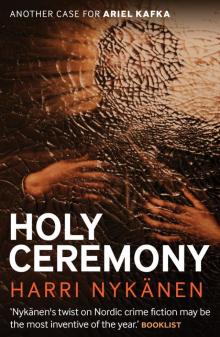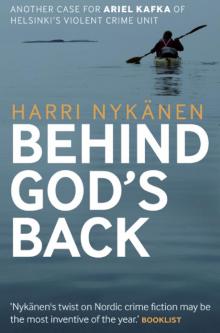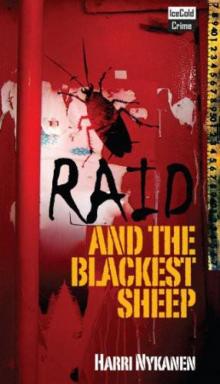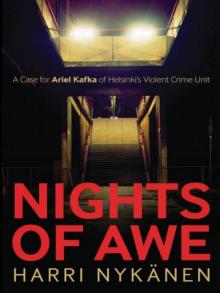- Home
- Harri Nykanen
Holy Ceremony
Holy Ceremony Read online
Harri Nykänen, born in Helsinki in 1953, was a well-known crime journalist before turning to fiction. He won the Clue Award for Finnish crime writing in 1990 and in 2001. His fiction exposes the local underworld through the eyes of the criminal, the terrorist and, most recently, from the point of view of an eccentric Helsinki police inspector called Ariel Kafka. This is the third in the Ariel Kafka series to appear in English. It follows on from the success of Nights of Awe and Behind God’s Back.
ALSO AVAILABLE FROM BITTER LEMON PRESS
BY HARRI NYKÄNEN
Nights of Awe
Behind God’s Back
BITTER LEMON PRESS
First published in the United Kingdom in 2018 by
Bitter Lemon Press, 47 Wilmington Square, London WC1X 0ET
www.bitterlemonpress.com
First published in Finnish as Pyhä toimitus
by Crime Time, Helsinki, 2011
© Harri Nykänen 2011
English translation © Kristian London, 2018
Bitter Lemon Press gratefully acknowledges the financial assistance of FILI – Finnish Literature Exchange and the support of the Arts Council of England.
English-language edition published by agreement with Harri Nykänen and Elina Ahlback Literary Agency, Helsinki, Finland
All rights reserved. No part of this publication may be reproduced in any form or by any means without written permission of the publisher
The moral rights of the author and the translator have been asserted in accordance with the Copyright, Designs, and Patents Act 1988
All the characters and events described in this novel are imaginary and any similarity with real people or events is purely coincidental.
A CIP record for this book is available from the British Library
eBook ISBN 978–1–908524–904
Typeset by Tetragon, London
Contents
Chapter 1
Chapter 2
Chapter 3
Chapter 4
Chapter 5
Chapter 6
Chapter 7
Chapter 8
Chapter 9
Chapter 10
Chapter 11
Chapter 12
Chapter 13
Chapter 14
Chapter 15
Chapter 16
Chapter 17
Chapter 18
Chapter 19
Chapter 20
Chapter 21
Chapter 22
Chapter 23
Chapter 24
Chapter 25
Chapter 26
Chapter 27
1
I eyed the naked woman sprawled face down on the leather sofa, her back covered in a dense web of text. My subordinate, Detective Jari Oksanen, peered over my shoulder: “Someone’s been watching too many American serial-killer movies.” Then he read the words aloud: “Evil is most dangerous when it dons the guise of holiness, and darkness cloaks itself in light… Cuckoo.”
It might have been the stick letters scrawled on the woman’s skin or the suspense-movie ambiance, but I was getting the sense that the body on the sofa was merely bait, and I had just stepped into a trap from which it was too late to extricate myself. I froze and raised my arms in front of my face, as if shielding myself from an attack. Oksanen looked in surprise at my primitive reaction, passed down from ancestors who lived millennia ago.
I resorted to routine to recover: “Did you find out who owns the flat?”
“I don’t know who the owner is, but the resident’s name is Reijo Laurén. Forty-five, give or take. Lived at this address for a couple of years now. Not too chummy with the neighbors. I got a cell phone number, too, but I’m not getting through. Arja’s checking out his info and background… What’s that mean?”
Oksanen pointed at the small of the woman’s back, which read Ps 91:12, and the similar sequences of letters and numbers underneath: Matt 10:28, Matt 23:33.
The first only took a second to register. We Jews know our Old Testament.
“I think it’s from the Bible, a verse from the Psalms.”
“Dang it. Just when I left my Bible at home,” Oksanen said, patting his pockets.
Below the woman’s right shoulder blade was a symbol resembling the mouth of a tunnel with a cross drawn inside it.
“Looks like an attic window,” Oksanen said.
“Matt 10:28 means the Gospel of Saint Matthew…” I looked around and zeroed in on the bookshelf. A quick scan turned up what I was hoping to find: an old, black-backed, leather-bound family Bible. I yanked it from the shelf. The names of those who had passed on were recorded on the flyleaf: Axel, 12.9.1949; Voitto, 4.6.1954; Kirsti, 17.1.1962…
Flipping to the New Testament, I found what I was looking for: And fear not them which kill the body, but are not able to kill the soul: but rather fear him which is able to destroy both soul and body in hell. The passage had been underlined in pencil.
I glanced out the window when I heard the sound of a car. Vuorio, the medical examiner, was just parking his gleaming new Benz in the courtyard below.
The apartment in Helsinki’s Töölö district wasn’t your typical crime scene, but crime is no respecter of time or place. A generous thousand square feet, decorated in a style that spoke of the owner’s affluence. The walls were hung with old representational art: landscapes, birds, bright spring snowfields and sun-dappled pine trunks, inlets with reedbeds and rowboats pulled up onshore. Some of the works might have even been worth something. The dark furniture and velvet upholstery conjured up images of an elderly person ensconced among jars of ointments, vials of pills, and photographs. There wasn’t the tiniest hint of life in the place.
The setting conjured up a memory from nearly forty years ago. My father and I had gone to visit an old aunt who lay in lace sheets, white as death. The stale air and smell of her medication made me nauseous. When she tried to touch my cheek, I pulled back and hid behind my dad in horror. The next night I had a nightmare of her pale hands scrabbling around, searching for me. Later, when I saw the movie Fiddler on the Roof, it had a similar scene, where Tevye’s deceased relatives come back from beyond the grave to put a stop to the marriage between his daughter and the butcher.
The living-room window faced westwards, onto the park-like courtyard, where the April lawn was still smeared to the ground from the weight of the past winter’s snow. Although the earth was bare, a six-foot pile of the grimy stuff still stood at the rear of the yard, where it had been plowed up against the trash shed. It had been a long winter. The bleak, gray day and naked trees gave the landscape a particularly unnerving, melancholy cast. I almost started thinking all hope was lost and the wisest course of action would be to serenely lay myself down, fold my hands across my chest, and wait for liberating death to arrive.
“It doesn’t seem like the apartment of someone that age,” I remarked.
Oksanen looked around. He clearly found the exoticism of the scene titillating. I could picture him that evening at the café, telling his rally buddies what he’d just seen. In such circumstances, the laws on investigation confidentiality tended not to carry a whole lot of weight.
“Yeah, the decor looks more like a seventy-year-old’s. Grandma used to have the same sort of armchair and bookshelf. Holy crap, and a painting almost exactly like that, too. A little bay with a boat on the shore.” Oksanen stared at the painting, entranced by his feeling of déjà vu. “One of the neighbors told me Laurén inherited the flat. Pretty weird he didn’t bother heading out to IKEA to pick up some newer furniture. That TV is genuine ’70s vintage, too.”
I opened the ventilation window; I needed fresh air. I wouldn’t have lasted twenty-four hours in the apartment without losing my mind.
The door sw
ung open and I saw Vuorio enter, huffing and purposefully swinging his satchel. He nodded as he passed us, and braked when he reached the deceased’s head. The medical examiner squatted down, stared at the woman’s face for a moment, surveyed her body from head to toe, and let his fingers graze a pea-sized mole on her shoulder. Then he stood.
“This is one for the memoirs,” he said, still breathing heavily from his climb. Vuorio was tremendously overweight. His hobby was hunting big game in Africa, but imagining him taking aim at a buffalo or a leopard on the savannah was like picturing Luciano Pavarotti scaling the south face of Mount Everest.
Vuorio’s comment perplexed me, because it seemed like he hadn’t paid the slightest attention to the writing on the woman’s skin.
“What?”
“For the first time in my career, the same person has been killed twice… or, to be exact, not killed, but killed herself twice… although there wasn’t any writing on the body then.” He paused, then continued, “This woman was found dead in her apartment yesterday. Had downed a vial of sedatives. I went to the scene myself. We brought her in for an autopsy, but for some reason she’s here now… And I know I’m not mistaken,” Vuorio said, anticipating my next question.
I moved on to the following one: “Where did she live?”
“Konala. Her name is Roosa Nevala. Sister came in to ID her. Had left a note; no indications of a crime. Takamäki’s team is handling it, in case you’re interested. According to the sister, Roosa had psychiatric problems, had been an inpatient for a long time but had gotten a place at a group home. Not everyone is built for this life, even when it’s softened by meds.”
“How can you be so sure it’s her?” Oksanen asked. “She’s lying on her stomach.”
“Even twins don’t have identical birthmarks.” Vuorio indicated the pinky-tip-sized birthmark on the left shoulder, then the left hand. “Three horizontal slash marks on the left wrist, operation scar behind the left knee, same face, hair, body type, age. If either of you wants to place a bet, I accept. What I’m saying is you have a pretty rare case here, but whether it’s a crime, now that’s a different matter. Doesn’t look like necrophilia; I can say that with relative confidence.”
I considered Vuorio’s words and decided he was right. The removal of a body from medical examiner custody was at most theft, or violation of the sanctity of the grave. Neither fell under the purview of the Violent Crimes Unit. More than anything, it sounded like the case belonged in the hands of a competent psychiatrist.
“I’d still be interested in finding out what the motive is,” Oksanen said, almost disappointed. I uncharitably reflected that the incident was sure to be of interest to the media, and what interested the media also interested Oksanen.
Vuorio went on. “I’m thinking it has to do with the message this poor girl appears to have ended up being the notepad for. The message is pretty heavy-duty, so the ramifications are presumably of the same caliber. Which means I wouldn’t be surprised if this case eventually ended up in your hands anyway.”
“What ramifications?” I asked.
“I doubt whoever stole the body and wrote that on it did it on a whim. You don’t just stroll into our unit and wheel out the first body you see. The writing refers to something.”
“The Bible?” I suggested.
Vuorio frowned and looked past me. “For he shall give his angels charge over thee, to keep thee in all thy ways… Thou shalt tread upon the lion and adder: the young lion and the dragon shalt thou trample under feet… Psalm 91. One of the best known, which is why I remember it too. We had to memorize it at confirmation camp. It has a lot of verses, and I don’t remember anything close to all of them. In any event, it strikes me that whoever wrote this has a pretty big chip on his shoulder about something.”
“How would Laurén have gotten the body out of your facility, if it is him? Laurén is the owner of the flat.”
“Can’t say. We’re not exactly the Bank of Finland; up until now none of our clients have been stolen for use in secret voodoo rituals. My guess is a staff member helped, or else the thief worked for us at some point and knows his way around.”
“You guys have surveillance cameras, don’t you?”
“Everywhere you turn. The doors are equipped with alarms, too. It’s unlikely the bodysnatcher was working alone. Just carrying the body up here to – what is this, the third floor? – would have taken significant strength. It must have been rolled up inside a rug or something similar. But I’d still be asking why rather than how. It says quite a lot that he was prepared to put his name and his future on the line. Why this sort of MO, which brands him as good as a pervert? Why not a nice, tidy letter? How did you guys find out about this?”
Our arrival on the scene had been prompted by an anonymous tip called into the general emergency line, and I told Vuorio so.
“So I presumed. In other words, I’m guessing this is a prelude to something bigger. It makes me think this is the first move in some sort of game. This corpse here is the first sacrificed pawn.”
Vuorio’s attitude toward cases could typically be described as disinterested; he only communicated as much as his job required. Now he seemed downright enthusiastic, as if he were participating in some roleplaying game, or solving a brain-teaser.
“Go talk with the neighbors; ask them if they’ve seen anything,” I ordered Oksanen.
“Why, if this isn’t even our case?”
“For now it is. We’ve already dragged ourselves all the way over here, so we’re not leaving until our work is done.”
Oksanen clearly begged to differ, but I ignored him. I turned my back and heard him trudging towards the door.
Before I had time to process Vuorio’s ideas, my phone vibrated, announcing an incoming call. I glanced at the number. It was Arja Stenman, one of my subordinates. I stepped over to the window. “What is it?”
“I found all sorts of stuff on Laurén. Owns the flat; inherited it from his aunt three years ago, studied cello at the Sibelius Academy, had a side gig as a member of a heavy metal band called Holy Night, convicted of narcotics possession and unlawful intimidation, lived in Tibet for a few years, divorced, one child, restraining order, spent almost a year at the psychiatric hospital in Kellokoski after a psychotic episode. Numerous employers within the past five years; last worked at a funeral home. The narcotics conviction is so old it was already removed from the register.”
“We were a little too hasty. This isn’t one of ours. The woman wasn’t killed.”
“What do you mean?”
I gave her the run-down.
“Doesn’t matter; we have to find Laurén, if for no other reason than to get him psychiatric treatment,” Stenman said. “I spoke with the sister of the deceased. According to her, Roosa was dating a man who could well be Laurén. Said the guy clearly had psychological problems that had a negative impact on her sister.”
“Put out an APB on him. And while you’re at it, check whether the medical examiner was a client of Laurén’s former employer, that funeral home. We’ll see who this case actually belongs to.”
“Ari.” Vuorio was standing next to the corpse, stout as a snowman. I tried to imagine him as the great white hunter, in sweat-stained khakis and a wide-brimmed Stetson, with little success. On the other hand, I had no trouble picturing him in a creaking rattan chair on the terrace of a colonial manor, sipping a gin and tonic or a mojito. “Come take a look at this.”
Vuorio had rolled the corpse on its side, revealing an envelope that had been hidden under its breast. I bent over to see the name printed on the white paper:
Ariel Kafka.
2
I opened the envelope, making sure not to leave any prints on it. The sole contents were a yellowed newspaper clipping and the following note, written on a slip of paper:
This is not the beginning of my work, nor is it the end. There are five evil dragons and three good angels, who together form the Sword of God the Good. At the beginning of ti
me, the dragons were strong, but goodness gathers strength over the years as we approach the end of the days of wickedness and the great cleansing. One dragon has been cast into darkness and filth, another burned with a purifying flame. But the battle will not be won until the most powerful dragon has been slain and cast into the fires of perdition. Only then will the Holy Ceremony come to its conclusion.
The Adorner of the Sacred Vault
The headline on the clipping read Maintenance man found dead in Kouvola septic tank. According to the date penciled on it, the article was from a 2008 issue of the Kouvola Sanomat. The story was about a maintenance man named Leo Anteroinen, born in 1951, who had been found brutally murdered in his septic tank. He was discovered by a friend who had been trying to reach him and eventually came by his home looking for him. The hatch to the tank had been left cracked.
After reading the clipping, I called Stenman and asked her to look up what she could find on the Kouvola murder.
Vuorio had finished his work and walked up to me. “What was in the letter?” He was sworn to confidentiality, so I let him read the message, which he handled as carefully as I had. “This is starting to feel as mystical as The Lord of the Rings. Any idea why your name was on the envelope?”
“Maybe he saw it in the paper and it stuck in his mind.”
“How did he know you’d be the one called to the scene?”
“He probably didn’t. But he knew it would be passed on to me anyway.”
“Based on the letter, it sounds like he wants you specifically to do the investigating, and that there’s some link to the incident mentioned in the clipping… well, there’s no point assuming.”
“I asked Stenman to get the preliminary investigation records.”
“I doubt our corpse here has anything to do with any of this; it was such a clear suicide. I get the sense that the perpetrator is trying to draw the attention of the police – meaning you – to himself and get them to take him seriously. The letter reinforces my hunch.”
Oksanen returned from making the rounds of the neighbors.

 Holy Ceremony
Holy Ceremony Behind God's Back
Behind God's Back Raid and the Blackest Sheep
Raid and the Blackest Sheep Nights of Awe
Nights of Awe